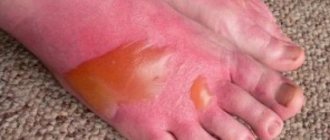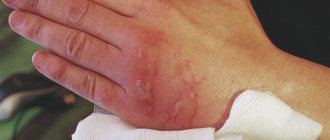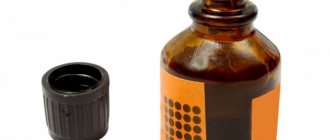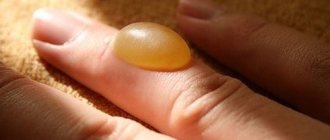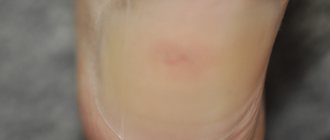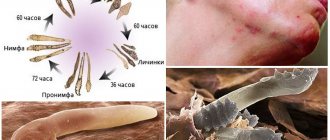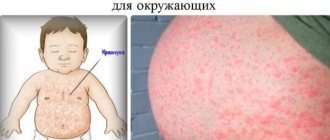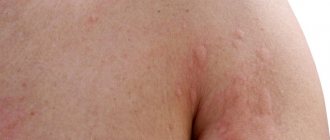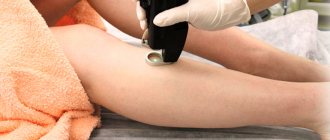From this article you will learn:
- How do sunburns appear?
- What are the dangers of sunburn for human health?
- What measures should you take if you are sunburned?
- What not to do if you have sunburn
- How to treat burns with medications and traditional methods
Sunburn is damage to the upper layer of the epidermis caused by UV rays. Most often, people experience minor skin burns that can be easily treated on their own. But severe damage to the epidermis often occurs. In these cases, more serious symptoms are observed, leading to complications. In this article we will tell you what to do if you have a sunburn, which actions will be useful and which can harm your health. In the latter cases, more serious symptoms are observed, leading to complications.
Why do sunburns occur?
The areas of the body most susceptible to burns to the skin are the face, neck, arms, back, shoulders. It is important to know what to do if these areas get sunburned. They are not protected by clothing and suffer the greatest impact from ultraviolet radiation. However, sun tolerance varies from person to person. It happens that while being exposed to the sun at the same time, some people get a burn, while others do not.
Whether your skin will burn or whether you will be able to avoid it depends on:
- Skin type and color (light-skinned people are more susceptible to ultraviolet radiation, dark-skinned people are more likely to withstand the sun of any intensity).
- Individual characteristics of the body.
- Existing dermatological problems (many moles, redness, acne, etc.).
- Sensitivity to the sun - it increases if you take phototoxic drugs (for example, antibiotics "Teracycline" and "Doxycycline", antiarrhythmic drugs "Cordarone" and "Amiodarone", sulfonamide drug "Biseptol", orange, bergamot and other types of vegetable oils). If you are prescribed these medications, try to avoid prolonged exposure to the sun, and do not sunbathe on purpose (in this case, protective creams will not soften the UV exposure).
Daily short exposure to the sun does not pose any danger. If your region regularly experiences sunny weather, the epidermis adapts in a certain way to exposure to ultraviolet radiation. It goes like this. Melanin pigment is formed in melanocytes (skin cells). It is responsible for changing the shade of the dermis, it becomes darker. The resulting melanin passes into the epidermal tissue, protecting the integument from the harmful effects of the sun. We can conclude: if you are in the sun for a short time and regularly, you will not get burns, your skin will get a tan.
Such severe skin damage as a burn is the result of a one-time exposure to ultraviolet radiation. Skin cells cannot quickly prepare for protection and die. Visually this manifests itself in the form of redness and inflammation. It is worth understanding that burns occur not only under direct rays. The question of what to do if your skin is sunburned is often asked by people who have never been under the sun. What is this connected with? It is also possible to be exposed to harmful ultraviolet rays in a solarium or in production, where special radiation equipment is used.
Different areas of the body are differently susceptible to radiation. Areas more susceptible to it: stomach, face, neck, chest, back. It is important to know what to do if you get a sunburn in these areas, as the skin burns very quickly here. The epidermis of the hands and feet is less sensitive to UV rays, the skin of the palms and feet is the most resistant to the sun. A low degree of body response is associated with a small number of melanocyte cells.
In addition to the above reasons, body burns can occur under the influence of radiation (radiation burns). In this case, they talk about ionizing and light radiation, which causes damage to the skin, similar to sunburn.
Prevention
To prevent sunburn, it is important to:
- use special sunscreens (creams, lotions, ointments);
- choose the right time to stay in the sun (the optimal period is from 10 to 11 a.m. and after 4 p.m., when solar radiation is less active);
- limit the duration of exposure to open sunlight (the more sensitive and lighter the skin, the less time you need to be in the sun);
- Wear sunglasses and a hat - they will partially protect sensitive facial skin from the sun and reduce the risk of sunstroke (heatstroke).
Sunburn is common. They cause inconvenience, cause pain, and can lead to the development of complications. This is why it is better to prevent the problem by using sunscreen and limiting your time in the open sun. If a burn does occur, you need to treat it correctly and in a timely manner, using special medications for sunburn. They will reduce pain and speed up the recovery of damaged skin, and prevent the development of complications.
Degrees of sunburn
With different sun intensities, the epidermis is injured in different ways.
Based on the depth of damage, burns can be divided into three types:
- Lungs . Only the very top layer of skin is injured. The problem can be recognized by the presence of redness, minor swelling and a slight feeling of discomfort. What to do with such a sunburn in a child and an adult? In general, the damage to the dermis is minor. Therefore, it is enough to wait for spontaneous healing.
- Moderate damage . Here you already feel quite strong discomfort; characteristic blisters with a yellowish liquid appear on the skin. The integument heals in 7–14 days.
- Heavy . In this case, the deepest layers of the skin are deformed. The main symptoms are severe pain, swelling, blisters. You feel unwell in your body. Severe sun damage is quite rare. Normally, ultraviolet radiation does not affect the deep layers of the epidermis.
Your condition after sun exposure will depend on the depth of the damage, as well as the size of the affected area. It has been noticed that a severe burn with a small area of spread is easier to bear, but takes longer to heal. At the same time, shallow effects that spread over a large area of the epidermis often cause malaise, nausea, and headaches.
In deformed areas, epidermal cells die, and the breakdown products of cellular substances pass into the blood. Partial intoxication of the body occurs. In large areas of damage, the number of dead cells is greater, which means that the body is struggling with a considerable amount of toxins.
How to get rid of sun spots
Getting rid of sun spots is difficult, but if you make an effort and use cosmetics correctly, it is possible. For these purposes you can:
- Contact a cosmetologist;
- Apply traditional medicine methods;
- Use cosmetic whitening creams.
With the help of medical cosmetology methods - laser therapy and chemical peels, you can get rid of brown spots after an unsuccessful tan. The laser affects the cells of the epidermis - chromatophores, which are responsible for intense pigment staining. Laser therapy is considered a safe method for getting rid of hyperpigmentation. The greatest effectiveness is achieved in cases with a small area of epidermal damage.
Chemical peels are used on areas of the skin with deep lesions. The skin is exposed to acids - glycolic, malic, tartaric, lactic. The disadvantage of chemical peeling is that the patient will have to undergo a series of procedures to reanimate damaged areas of the epidermis. During the treatment period, it is strictly not recommended to be exposed to ultraviolet rays, so the procedure should be carried out in winter. Read more about peelings in this article.
You can get rid of age spots after sunbathing using whitening creams. Please note that a whitening cream containing the following components will be able to cope with the task:
- Various types of acids: ascorbic, mandelic, albatine, azelaic, koic;
- Dermawhite R complex;
- Aloesin or aloe vera extract;
- Gentesic acid ester;
- Licorice root extract;
- Acetylcysteine;
- Hydroquinone;
- Tretinol.
The most popular creams with a whitening effect are: White Effect, Melascrine, Storyderm oxygen cream, Microcellulaire, Alpha, Erborian kojic acid cream.
What are the dangers of sunburn for humans?
In addition to information on what to do if you have a severe sunburn, it is useful to know how to prevent this unpleasant situation. To keep your skin healthy after tanning, you must follow certain rules. Light-skinned people need to prepare especially carefully for walks in the sun. They are more sensitive to ultraviolet radiation; damage to the skin surface is possible within 30 minutes of exposure to strong rays.
Which places on the body are more sensitive to ultraviolet radiation:
- face;
- shoulders;
- back;
- upper chest;
- legs;
- lateral thighs.
How does skin damage from the sun occur? UVB rays are dangerous for humans. They are absorbed by the upper layers of the epidermis. Tissue cells release harmful substances that lead to pain, inflammation and swelling.
Recommended reading:
Other rays from the solar spectrum are UVA. They pass into deeper layers, affecting the dermis. As a result, the covers are deformed and burns form. This type of radiation is also dangerous because it accelerates the aging process. Next, we will answer the question of what to do for deep sunburn of the skin.
UV rays have a negative effect on the body's immune system. If the body's defense systems are compromised, it becomes more difficult for us to cope with harmful microorganisms and viruses. This can be one of the causes of colds in the summer. If the immune system is severely weakened, the herpes virus may be activated in the body.
Folk remedies that help against sunburn
To carry out therapeutic measures at home, you can also use the following recipes from traditional medicine:
- Aloe juice. Dilute aloe juice in cool boiled water, 2 tablespoons of juice - 2 tablespoons. spoons of water. Soak a napkin in this solution and wipe your burned face.
- Oatmeal. Pour a small amount of cold water over a handful of lightly crushed flakes to form a paste, which you can apply to your face. As soon as the oatmeal mask begins to dry out, remove it with a cool, damp pad and apply the next layer.
- Oat flour. Dilute 1 tbsp in 1 glass of clean and warm water. spoon of oatmeal, and then cool the resulting composition. You can add a couple more pieces of ice before use.
- Frozen cottage cheese. Freeze it in the freezer until solid, then wrap it in a piece of gauze and apply it to your face.
- Raw potatoes and cucumber. Just apply slices of fresh cucumber or peeled potatoes (you can use grated mixture) on your face. It is advisable that the vegetables are cold.
- Sauerkraut. Apply the leaves to your face for 5-10 minutes.
- Compresses made from weakly brewed and very cold tea, both black and green, are also a good remedy for sunburn.
Severe sunburn with blistering
The main symptoms of sunburn
People often get asked what to do if they have a mild sunburn. Indeed, these injuries are much more common. Their symptoms are pain in the affected areas, slight inflammation, and dryness. During the healing process, itching occurs and the affected area peels off. An individual reaction to the sun is also possible. Additional symptoms usually appear 3 to 12 hours after sun exposure.
Redness.
By the presence of redness after tanning, you can almost definitely judge a burn. Redness is a consequence of the inflammatory process. At the same time, the cells of the upper layers of the epidermis die. As soon as tissue regeneration begins, inflammation subsides.
Pain.
Damage from radiation is always accompanied by pain. The degree of discomfort depends on the size of the affected area and the depth of the burn. The pain increases as tissue destruction occurs. Nerve endings become irritated, causing discomfort. The first signs of discomfort appear a couple of hours after irradiation. The pain may last for several days.
In what cases is the most severe discomfort felt:
- for large affected areas;
- when damage penetrates into the deep layers of the skin (usually blisters appear);
- if the burn areas are again exposed to sunlight or a heat source;
- for lesions of particularly sensitive areas (face, neck, hands).
Blisters.
Blisters are a consequence of severe deformation of the epidermis. Light-skinned people with sensitive skin are most susceptible to them. Water bubbles form due to the detachment of the upper parts of the epidermis, and serous fluid accumulates in the cavities between the layers of the skin.
The blisters themselves do not have any negative effect on the body. During tissue regeneration, they dry out, the skin wrinkles and falls off. The epidermis is restored within a period of several days to a couple of weeks. Larger blisters take longer to heal.
What you should never do if you have a sunburn is pop the blisters:
- under the skin there is an unhealed wound, which is very sensitive (even air touching the skin causes pain);
- there is a possibility of re-infection;
- an unhealed wound constantly dries out again, which slows down skin restoration.
What to do to combat blisters: treat these areas with an antiseptic, then apply a bandage. It is worth repeating disinfection 2-3 times a day. The bandage must be applied carefully, without squeezing the wound, so as not to break the blisters.
Edema.
Burns are often accompanied by swelling. A similar reaction occurs on the face, eyelids, and more often on the legs. A possible cause of the symptom is an allergy. If an area of the body that is not exposed to the sun is swollen, a possible cause is a chronic disease (pathology of the liver, kidneys, problems with hormones).
In some cases, the first thing to do in case of swelling is to consult a doctor.
Symptoms that indicate the need for medical attention:
- the swelling has spread to a large area of the body, it is clearly defined (in this case, the cause of the problem may be an imbalance of water and electrolyte balance, as well as problems with blood vessels);
- swelling has formed on another part of the body that is not exposed to the sun;
- swelling grows quickly;
- within 1-2 days after sunbathing, the swelling does not resolve.
Itching.
Often when the epidermis is burned, itching appears. However, this manifestation does not always occur. One of the reasons is the healing of damaged tissue. Sometimes the problem appears due to an existing allergy to ultraviolet radiation.
Rash.
The rash cannot be the result of a burn. This reaction can occur due to allergies, and it is not necessary to be in the sun for a long time. The problem has a scientific name - photodermatosis (increased sensitivity of the body to ultraviolet radiation). What is recommended to do for a rash after a sunburn? It is imperative to undergo a medical examination for the presence of the described disease.
A burn and rash due to photodermatosis can occur simultaneously. The presence of a burn can be recognized by characteristic symptoms. A rash may appear both before and after their onset. Skin rashes mainly form on the exposed surface of the skin.
Burn spots.
There are two common causes of spots after prolonged exposure to the sun. Pinkish and red are localized at the site of irradiation. They occur due to photodermatosis. Often the spots extend beyond the damaged area. Along with them, rashes and swelling often occur, which also indicate the presence of allergies.
Pigmented spots form during the healing of the irradiated area (5-6 days after tanning). During this period, dead cells exfoliate, darkening of the dermis appears (sometimes the spots are lighter than the rest of the skin). The reaction goes away after a few weeks (months). The main cause of pigment is excessive production of melanin, the substance responsible for tanning. After irradiation, the epidermis is damaged, melanin is produced unevenly, resulting in spots.
Chills.
The cause of chills is spasm and involuntary contraction of certain muscle groups. Burns rarely lead to this symptom. This reaction is possible only with large areas of skin damage. Next, we'll look at what to do if you have a sunburn and chills.
The following symptom is also common: coldness is felt at the site of irradiation, but only in the affected area. This reaction does not alleviate the painful condition. Its cause is partial damage to thermoreceptors and disruption of their functioning.
Burns at different ages
The question of what to do if your body is severely sunburned can concern people of all ages. It is important to understand that the main symptoms and treatment regimen will differ depending on the age of the victim.
In newborns, the skin of the body is more sensitive to ultraviolet radiation, so it burns quickly. The problem can be recognized by general symptoms: sleep disturbance, loss of appetite, high fever, nausea, vomiting. In infants, cellular tissue is able to quickly regenerate, so healing occurs in the shortest possible time.
In older children, as well as in adolescents, irradiation of the epidermis is a rather rare occurrence. Since they are often exposed to the sun, the cells quickly get used to it and no burn reactions occur. In case of sunburn, the skin also heals very quickly.
Skin burns are also common in adults. The depth and extent of the damage will depend on the strength of the rays and the time spent in the sun. Usually, with burns, only local symptoms appear, without complications.
In older people, tissue cells are less susceptible to intense ultraviolet radiation; the epidermis easily tolerates long exposure to the sun. If there is damage, the symptoms are less noticeable because the body's responses are weaker. However, it must be taken into account that restoration of cellular structure in older people occurs more slowly. This makes complications more likely. Therefore, it is worth familiarizing yourself in advance with what to do if you have a sunburn.
Symptoms
The most common are mild sunburns, manifested by local soreness, redness, and dry skin. As healing progresses, itching may appear and the surface layer of skin begins to peel off. However, depending on the intensity and duration of ultraviolet exposure and the individual characteristics of the body, other signs of sunburn may appear. As a rule, unpleasant symptoms do not occur immediately, but 3-12 hours after irradiation.
Redness
Redness of the skin is the most common symptom of sunburn. Redness appears as a result of inflammatory reactions accompanying the destruction of damaged epidermal cells. As cellular structures are restored, inflammation decreases and redness disappears.
How quickly does a sunburn heal?
It is known that the main local symptoms of damage subside within a day. Minor inflammation, itching and other symptoms may last for several days. Full recovery occurs within a week.
How quickly your cells regenerate depends on factors such as:
- severity of injury;
- efficiency of first aid;
- correct selection of medications;
- size of the damaged area;
- presence of chronic diseases
- work of one's own immunity;
- the presence of purulent inflammation;
- age of the victim;
- sensitivity of the wound at the site of the burn.
What to do for a sunburn: first aid
For any degree of damage, it is necessary to resort to certain actions.
We'll tell you what to do if you have a sunburn and the following symptoms:
1. If you feel that your skin is burned, immediately leave the area with open access to the sun. It is advisable to go to a cool room or a place with shade.
2. If you have symptoms such as chills, dizziness, headache, general malaise, nausea, call an ambulance immediately. In addition to exposure to radiation, you could get heatstroke.
3. If there are no dangerous symptoms, just do the following: apply sterile gauze or a small piece of cloth, previously soaked in cold water, to the affected area. Change the bandage every 15–20 minutes. Perform first aid as carefully as possible, without injuring the skin. As a result of these actions, you will reduce pain and also moisturize the epidermis, preventing severe cell destruction.
4. Take a shower (the water should be cool - about +30 °C). If a certain part of the body is burned, you can make baths and soak the burned area there.
5. To prevent dehydration, drink plenty of water. What is needed is water - drinking or mineral.
6. If you are experiencing severe pain, take a pain reliever. What to do in case of sunburn and fever? Take an antipyretic, for example, aspirin, analgin, ibuprofen, baralgin.
If the exposure was not strong or you are slightly overheated in the sun, you can get by with the first aid described. But even with minor damage, it is still recommended to take a break from walking in sunny weather. It is necessary to carry out additional measures to treat the skin. We will talk about them further. If you experience serious symptoms such as headache, nausea, chills, general weakness in the body, the first thing to do is consult a doctor.
First aid
If you experience symptoms of sunburn, you should:
- hide from the sun's rays in the shade, if possible, go indoors;
- Apply a wet compress to the damaged areas for 15-20 minutes (the water temperature should be close to body temperature, if not too cold);
- treat the skin with burn foam (Panthenol, Bepantol).
First aid for radiation burns consists of cooling the damaged area with a compress and then applying a dry bandage and contacting a doctor. If you have a radiation or sunburn, you should not treat damaged skin with greasy ointments or oils or apply ice - this will only worsen the condition and cause additional damage to skin cells.
If, in addition to local symptoms, signs of heat stroke appear (headache, nausea, chills, malaise), you should consult a doctor as soon as possible.
What is prohibited to do if you are “burnt” in the sun
What do people immediately start doing after a burn? Of course, they try to treat the skin on their own. It is important that your knowledge in this matter coincides with reality, since erroneous or incorrect medical treatment can aggravate the wound and harm the health of the body as a whole.
Below we will describe what not to do if you have a sunburn:
- It is not recommended to apply or lubricate the affected area with ice cubes. This action will alleviate the pain, but subsequently the upper layers of the epidermis will begin to die. The healing process will take much longer. In addition, scars may form, which also take a long time to regenerate.
- It is forbidden to wash the damaged areas with alkaline soap, scrub, or rub them with hard washcloths. Because of this, the inflammatory reaction may increase and the protective layer of the skin will be erased.
- It is strictly forbidden to use formulations containing alcohol. Tissue cells will lose water and their destruction will intensify.
- Also, you should not lubricate your body with very greasy products (creams), which clog the pores, preventing oxygen from reaching the cells. This applies to vegetable oils, animal fats, and petroleum jelly.
- To protect yourself from additional infection, do not touch blisters and papules with your hands. You cannot make punctures or open blisters.
- What else you should not do if you have a sunburn: temporarily postpone drinking alcohol, strong tea and coffee. These drinks contribute to dehydration, which is undesirable when the surface of the epidermis is healing.
It is useful to limit exposure to the sun for a long time (for the period of wound healing). Before going outside, wear clothing that covers the affected areas.
How to treat sunburn
If the skin is only slightly burned (first and second stages of damage), you can treat yourself. If the severity is severe, try to immediately go to the doctor. All actions related to the treatment of burns can be divided into three groups:
Therapy with external means.
What to do if you have a severe sunburn to speed up skin healing: use creams, sprays, ointments. Before use, you must read the instructions, since almost every product has contraindications:
- "Panthenol" . This ointment restores the affected areas of the skin, softens, promotes scar healing, relieves inflammation, and protects against new infections. The product is used 2-4 times a day, but you must first read the instructions. If some areas of the lesions are infected, apply an antiseptic to them first.
- Aerosol "Livian" . This product effectively relieves inflammation, relieves pain, and disinfects the affected area. Use once daily.
- Elovera ointment . Promotes the regeneration of tissue cells, restores their metabolism. The product must not be used by persons under 18 years of age. Apply the ointment 2-4 times a day.
- "Carotoline" . Effectively protects the epidermis from the harmful effects of sunlight, improves metabolism in tissues. Use the product 1-2 times a day. First apply it to a sterile cloth, then apply it to the skin.
- Balsam "Viniline" . The product has an antiseptic effect and accelerates healing. Use 2-4 times a day, spreading the product onto the wound. You can use sterile wipes, as in the previous paragraph.
- Zinc ointment, Calamine lotion, Desitin . These products have a drying effect and fight inflammation well. Indicated for use in mild stages of damage. Use them 2-3 times a day.
- Aerosol "Olazol" . Accelerates the restoration of cellular tissues. Use 1-4 times daily.
- Gel and ointment "Solcoseryl" . The product promotes tissue restoration and increases collagen formation. Use the gel 2-3 times a day, after cleansing the skin before doing so. The ointment is applied 1-2 times a day, applied to already healing areas.
- Psilo-balm (diphenhydramine) . It significantly reduces pain, itching, swelling, and cools the skin. The product is used 3-4 times a day.
- Actovegin ointment . The drug improves healing. At the beginning of use, painful discomfort may be felt. Use the product 2 times a day when the wound has already begun to heal.
- Gel "Floceta" . Reduces itching, promotes healing, has a cooling effect.
- "Eplan" . The product promotes the healing of burns, restores and protects the body. For application, read the instructions; the optimal number of applications is several times a day.
- "Radevit" . The product softens, reduces itching, and effectively protects the skin. Use it twice a day, applying a thin layer.
- "Sudocrem" . The product is able to heal damage, has an anesthetic and softening effect.
- "Sinaflan" . The drug reduces itching and relieves inflammation. This product is a hormonal product, so it should be purchased only after a doctor’s prescription.
Treatment with medications for internal use.
When self-medicating, be careful with medications. Vitamins (groups E, C, A) are relatively safe and can be taken with confidence. For the number of uses, see the instructions. Duration of treatment is about 10–30 days.
What to do if you have a sunburn, if there is swelling of the legs, pain and other symptoms: use anti-inflammatory medications such as ibuprofen, paracetamol. They reduce pain discomfort, relieve swelling and inflammation. At the beginning of treatment, you can take one tablet every 4-6 hours. For more detailed information, see the instructions.
In addition to the listed drugs, it is useful to use antihistamines (anti-allergenic) agents (tavegil, dibazol, loratadine, diphenhydramine, etc.). They prevent the development of allergies, relieve itching and swelling. Before use, read the instructions.
Folk remedies.
If you cannot make a wet gauze bandage at the moment, you can use regular wet wipes, just make sure that they are without perfume additives. Apply the napkin to the damaged area.
- Many people know from childhood that you can apply kefir or sour cream . But this method does not have proper medical justification. Sour cream has nutritional properties, but does not relieve the symptoms of damage.
- For homemade products, chilled chicken egg white . Apply it to the burned area and wait until it dries. Then do it again. The product will partially relieve inflammation, soothe the skin and prevent it from drying out. Ice and other products from the freezer should not be applied to the skin itself. To cool, keep them 5-10cm away from damage.
- What else can you do for a burn using folk remedies: prepare a mushy mixture of potatoes or carrots, beets, cucumber and pumpkin . Apply it to your skin. The composition effectively relieves pain, itching, burning. Watermelon juice can improve the condition of the damage. Soak a napkin in it and apply it to the burn site. You can also use the following components for the compress:
- Lotions from mint leaves . The herb is brewed in boiling water, then it should cool slightly.
- Infusion of nettle flowers.
All the described remedies significantly improve the condition of the skin, but they are not able to relieve the burn in a short time. It will take a long time to undergo treatment.
Drugs
In case of severe damage to the skin, treatment of sunburn is carried out using special external products (ointment, cream, gel, foam) that accelerate healing, moisturize the skin, and prevent infection of the damaged surface. This is necessary because sunburn causes pain, interferes with normal sleep, makes it difficult to wear clothes and causes other everyday inconveniences.
There are various drugs for sunburn on the pharmaceutical market.
- Bepanten. The drug based on dexpanthenol has a regenerating, moisturizing and antiseptic effect. Suitable for treating burns in children and adults. Available in the form of cream and ointment. It is best to use the cream immediately after injury, and at later stages of healing it is recommended to treat the skin with ointment. Frequency of application – 1-2 times a day.
- Panthenol. An effective remedy for sunburn based on dexpanthenol. It has a pronounced healing and moderate anti-inflammatory effect. Available in the form of spray, cream, ointment. The foam is applied to damaged skin immediately after receiving a burn, without rubbing. After absorption of the product, the treatment can be repeated. Further treatment can be carried out with foam, cream or ointment.
- Olazol. Aerosol based on sea buckthorn oil, boric acid, benzocaine and anesthesin, chloramphenicol. Anesthesin and benzocaine eliminate pain, sea buckthorn oil promotes rapid healing, and boric acid and chloramphenicol exhibit antiseptic and antibacterial properties. Foam is applied to damaged areas up to 4 times a day. Olazol is contraindicated for use in case of kidney problems, pregnant and lactating women, and children under 2 years of age. It is also not recommended to apply this sunburn remedy to large areas.
- Solcoseryl. The drug is based on a protein-free blood extract from healthy dairy calves, which activates cellular metabolic processes and stimulates the regeneration of damaged cellular structures. Ointment or jelly is used to treat burns. It is recommended to smear the damaged skin with the medicine 2-3 times a day.
Treatment for sunburn on the face
The epidermis of the face is very sensitive to ultraviolet radiation, and burns are most often localized here. The face is open all the time, it is easier for the rays to affect the dermis. However, the damage is mostly minor. This is a slight inflammation of the upper layers of the epidermis (usually redness occurs on the nose, cheeks and forehead, since these are the protruding parts of the face). If the sun was strong, slight swelling may begin.
What to do if you have a sunburn? First, apply Panthenol ointment to the damaged area. Spray the rest of the skin with a spray (Olazol is suitable). In general, modern medicine offers a huge range of drugs for the treatment of burns. All of them are effective and have an affordable price. In this case, medications are preferable to folk remedies.

